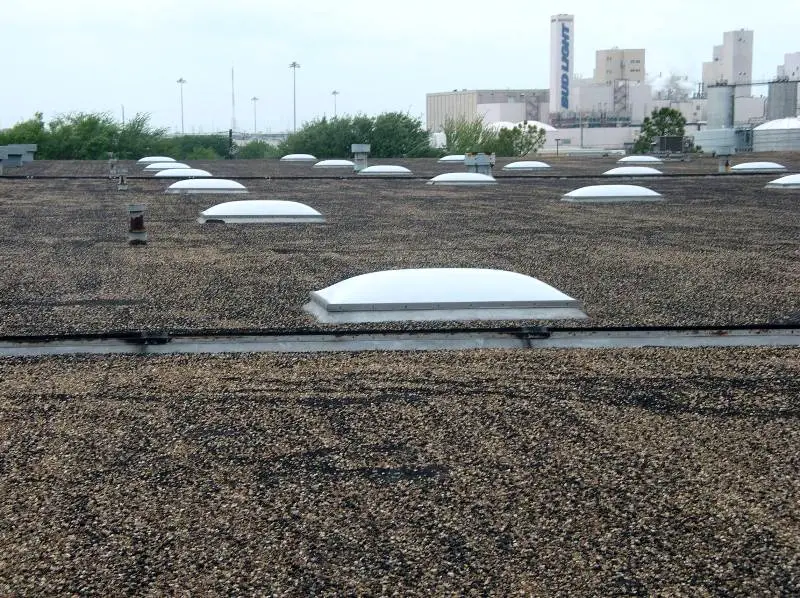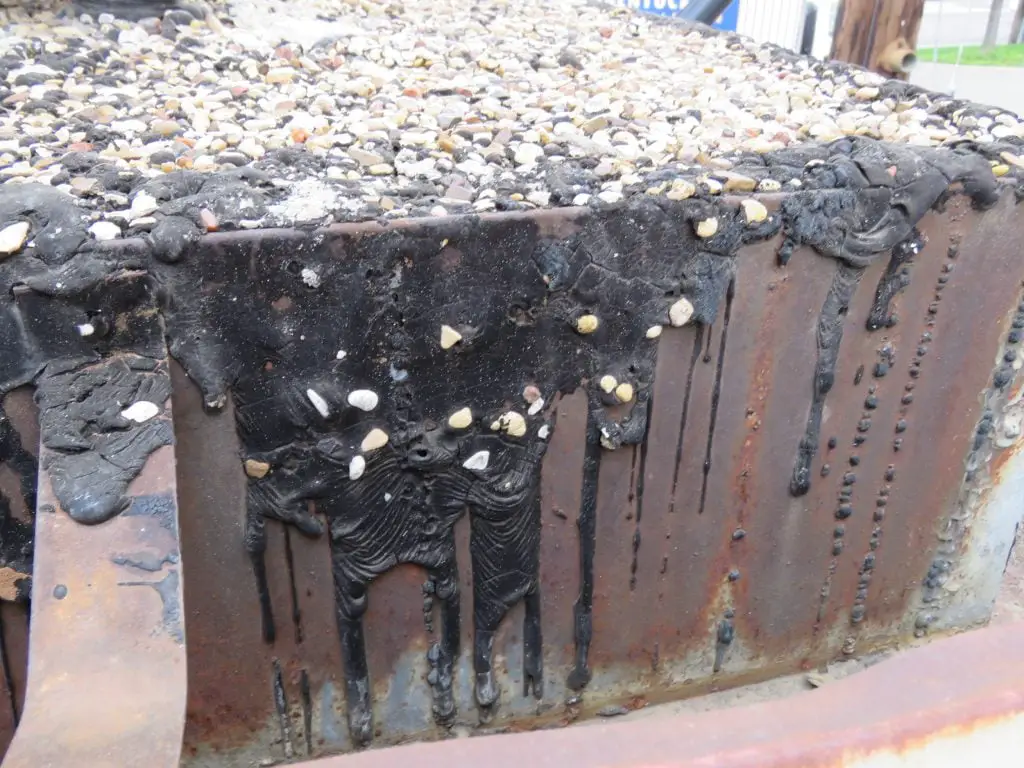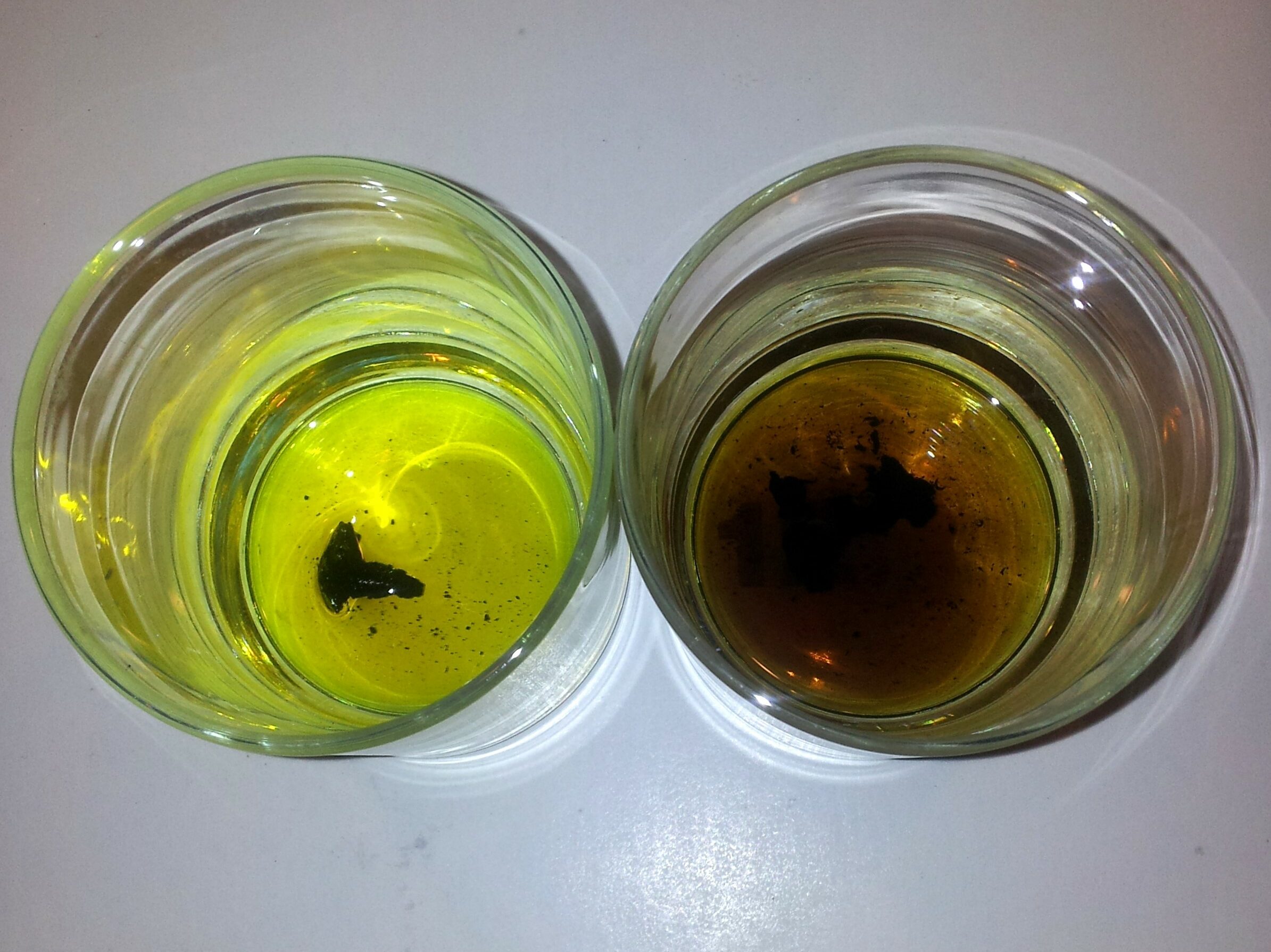Coal Tar Pitch Roofing Explained
By Jack Gray, Roof Online Editor • Last updated March 18, 2024
Table of Contents
- What is Coal Tar Pitch Roofing?
- How Coal Tar Pitch is Made
- How Coal Tar Pitch Roofs are “Built Up”
- How to Tell Coal Tar Pitch and Asphalt Roofs Apart
- Coal Tar Pitch Roof Repairs
- “Self-Healing” Coal Tar Pitch Membranes
- Weight of Coal Tar Pitch Roofs
- Related Articles
- External Sources & References for Coal Tar Pitch Roofing Information

What is Coal Tar Pitch Roofing?
Coal tar pitch roofing is a type of built-up roofing in which coal tar pitch forms the waterproofing component of the roof membrane.
Coal tar pitch roofing is the original “tar and gravel” roof.
It was so common and used on so many flat roofs for such a long time that even today, when most built-up roofs are asphalt-based and use no “tar”, they are still called “tar and gravel”.
Coal tar pitch is very rarely used today, due to the health safety precautions which must be taken when working with it, as well as the large number of cheaper single-ply roofing alternatives now on the market.
How Coal Tar Pitch is Made
Coal tar pitch is produced by distilling or heat-treating coal tar, which is a by-product of the production of coke or coal gas.
Although it is technically a fluid, coal tar pitch is extremely viscous, and can be considered a solid for practical purposes at normal ambient temperatures.
How Coal Tar Pitch Roofs are “Built Up”
When used in roofing, coal tar pitch is melted on-site in an industrial kettle and applied to the roof (normally with mops) as a hot liquid.
Pitch-impregnated roofing felts are installed in overlapping courses during the application of the hot coal tar pitch to reinforce and strengthen the roof membrane.
A layer of coal tar pitch that has been applied to the roof and the layer of reinforcing felts that are set into it is called a “ply”. One ply in a finished coal tar roof is usually an eighth to a quarter of an inch thick.
Typical coal tar pitch built-up roofs have four or five plies. At the end of the installation, gravel is typically set into an additional surface layer of hot liquid coal tar pitch (called a flood coat).
The gravel surface provides fire-resistance and protects the coal tar pitch membrane from UV rays, foot traffic, and hail damage.
How to Tell Coal Tar Pitch and Asphalt Roofs Apart
It’s important to know whether the roof you’ll be working on is asphalt or coal tar pitch for a few reasons. There are different safety requirements when it comes to removing a coal tar pitch roof.
Asphalt and coal tar pitch are actually incompatible materials, so you need to know what you’re dealing with before you make any repairs. You really don’t want to use pitch-based material to repair an asphalt roof or vice versa.
Coal tar pitch also behaves differently physically. Asphalt turns hard and rigid, once it cools. Asphalt becomes more and more brittle as it ages. Coal tar pitch doesn’t.

We once saw a roofing crew (who didn’t know it was coal tar pitch) cut a hole in a coal tar pitch roof in order to install an exhaust vent system for the brand new restaurant kitchen below.
The friction from the circular saw they used to cut through the roof caused enough heat to melt the edge of the roof around the new hole.
The now-liquid pitch dripped down through the hole and got all over everything. Coal tar pitch is extremely hard to remove, by the way. Some furious phone calls between the general contractor and the roofing company ensued.
The easiest way to conclusively identify a roof as being either asphalt or coal tar pitch is to take a small chunk of the material and drop it into some lighter fluid.
Coal tar pitch will soon turn the lighter fluid a green/yellow color. Asphalt will turn it brown. See the picture below.

Coal Tar Pitch Roof Repairs
Extensive repairs on a coal tar pitch roof system should be made by a roofing contractor with experience in coal tar pitch roofing.
The number of contractors with this kind of experience is declining steadily, so you may have to settle for a contractor with experience in asphalt built-up roofing. Of course, the number of contractors with experience in built-up roofing in general is also declining…
You can easily make smaller repairs yourself by applying a 5-course roof cement patch to damaged or deteriorated areas of the roof.
See our article on roof cement for directions on applying a 5-course fabric and mastic (another word for “roof cement”) roof patch. You will need coal tar pitch-based roofing mastic.
The important thing to remember when repairing a coal tar pitch roof is that coal tar pitch is not compatible with roofing asphalt or roof repair products made out of asphalt. When working on a coal tar pitch roof, you have to use coal tar pitch-based materials.
You want to be aware of this, and you want to double-check to make sure that your roofing contractor is aware of this as well, because many contractors don’t know.
It takes a while for asphalt to noticeably damage a coal tar pitch roof, but essentially what happens is that the asphalt and the coal tar pitch begin to combine chemically, to the detriment of each material.
“Self-Healing” Coal Tar Pitch Membranes
Coal tar pitch roofs are noted for their ability to “self-heal”: a coal tar pitch roof membrane will slowly fill in small punctures or stress cracks all by itself due to its fluidity.
Unlike almost all other low-slope roofing materials, and especially asphalt, coal tar pitch is almost completely unaffected by standing water. Thanks to its unusual water resistance, coal tar pitch roofs have the lowest roof pitch allowed by code for any type of roof at ⅛-in-12 (0.60 degrees).
Because of its permanent fluidity, coal tar pitch also has a very low maximum recommended roof slope (½-in-12), because if it is applied to anything steeper, the material will tend to slowly flow down the roof.
Weight of Coal Tar Pitch Roofs
A coal tar pitch roof is one of the heaviest types of low-slope roof. It is much heavier than the single-ply roofs that make up the majority of new roofs being installed today (with the exception of ballasted systems).
The relatively large mass of a coal tar pitch roof membrane helps it outperform other roof types when it comes to resisting damage from hail, foot traffic, and thermal shock.
A typical gravel-surfaced coal tar pitch roof weighs about 6.3 pounds per square foot, while a smooth surfaced coal tar pitch roof weighs about 2.6 pounds per square foot.
About the Author
Jack Gray is a principal roof consultant and vice president at the Moriarty Corporation, an award-winning building enclosure consultant firm founded in 1967. He is also the editor of the Roof Online website.

Mr. Gray has worked in the roofing industry for over 25 years, with training and practical experience in roof installation, roof inspection, roof safety, roof condition assessment, construction estimating, roof design & specification, quality assurance, roof maintenance & repair, and roof asset management.
He was awarded the Registered Roof Observer (RRO) professional credential in 2009.
He also served as an infantry paratrooper in the 82nd Airborne Division and has a B.A. from Cornell University. Read full bio.
Related Articles
- Asphalt (Hot) Roofing
- Built-up Roofs (BUR)
- Coal Tar Pitch Roofing Manufacturers List
- Modified Bitumen Roofing
External Sources & References for Coal Tar Pitch Roofing Information
1. Recommended for Further Reading: Manual of Low-Slope Roof Systems: Fourth Edition by C.W. Griffin & Richard Fricklas
2. General: See this informative, in-depth general article about various roof systems at the Whole Building Design Guide site, which is maintained by the National Institute of Building Sciences.
3. General: A good short introductory article on coal tar pitch roofing, “Coal-Tar Pitch Update” by roof expert Dick Fricklas, is archived on the Buildings.com website. The article is from 2009.
4. General: Coal Tar Roofing Systems – Rugged, Recycled, Reflective, Reliable by Kevin Ochis is a very good general introduction to coal tar pitch roofing (but keep in mind that the article was written by a coal tar pitch roofing manufacturer). From the November 2013 issue of IIBEC Interface.
5. General: The Pitch Drop Experiment. Check out the decades-long experiment that’s still going on at Australia’s University of Queensland, intended to demonstrate the fluidity of pitch. You can watch the pitch in real time as it drips once every 13 years or so. This is at room temperature; it gets much hotter on a roof, decreasing viscosity, and producing the “self-healing” quality for which pitch roofs are esteemed.
6. Safety: Learn about health risks related to coal tar pitch exposure on the website of the National Center for Biotechnology Information. Safety precautions are important when working with this material.
7. Safety: The Coal Tar Pitch Volatiles page at the OSHA website.
8. Safety: See this material safety data sheet for health and safety information about coal tar pitch at the Durapax website. This is only an example and other products and brands may be different.
9. Technical: See this coal tar membrane system specification, as well as Coal Tar Application and Design Considerations for insight into how a coal tar pitch roof system is put together. Both documents are made available by Durapax.
10. Technical: See this product data sheet for the technical characteristics of coal tar pitch at the Durapax website. This is only an example and other products and brands may be different.